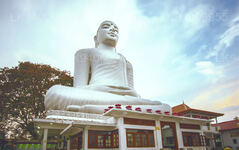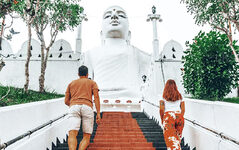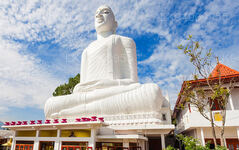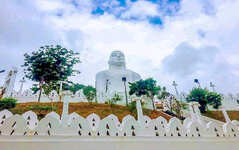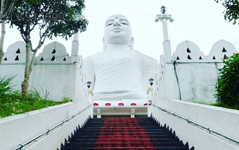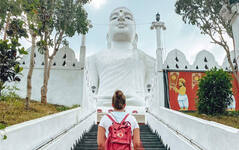
Kandy City
Kandy, en malerisk by i det centrale Sri Lanka, er kendt for sin rige kulturarv, livlige festivaler og smukke natur. Beliggende midt i frodige bakker, er den hjemsted for Tandtemplet, der er på UNESCOs verdensarvsliste, og byder på en betagende blanding af historie og naturlig pragt.
Bahirawakanda Vihara Buddha Statue
Rising from a hill adjoining the holy city of Kandy is the giant Buddha statue of Bahirawa Kanda. The statue is a mere 2km from the Temple of The Tooth Relic and was built in 1972.
Folklore
Many legends surround the hill of Bahirawa Kanda which means ‘gnome mountain’; and about how this statue came to be. Chief amongst these are two stories.
The first speaks of an ancient temple to the primitive god of protection, Bahiravar; which was implanted there during the reign of the Nayakkar Kings. During the olden days in India, the standard methods of worship for this god often involved animal sacrifice; though human sacrifice was never involved. But for some reason this practice seems to have gotten twisted in the localisation process; and the priests of this temple threatened the wrath of the god unless hundreds of virgin women were sacrificed in time. The naive people of the region handed over a large number of girls for sacrifice and lived in fear of the god’s wrath. However, this came to an end when the fiance of the Chief of the Royal Mahouts was taken for sacrifice. The man, whose name was Dunuwilla Gajanayake Nilame, used his power in the palace and his bravery to get her released; and caused such a great disturbance that the sacrificing ritual was broken. This marked the end of the people’s fear and superstition; and the temple was abandoned with time.
Another story speaks of how the hill gained the name ‘Gnome Mountain’ or ‘Devil’s Hill’. According to this legend there was a time in the past when the mountain emitted strange noises and engulfed the people who lived nearby in abject fear. They believed that it was the work of an evil gnome and searched for a way to appease it. Meanwhile, unknown to anyone, an actual gnome had infilitrated the palace and taken the place of one of the ministers. Realising the opportunity; the ‘minister’ advised the king that the gnome would be appeased if a beautiful virgin was sacrificed every year, and hence a new superstition began. But then one year; the nominated sacrifice was the lover of the fake minister’s very own son. The villagers kidnapped her during the night, took her to the hill and left her there. The minister’s son discovered this in the morning and immediately set off to rescue her. He fought the gnome , his father, who had been there for his own nefarious purposes; and returned to the village. The alarmed and fearful people had begun to wonder if the rescue of the sacrifice had angered the gnome; when the cunning son quickly made a gnome sound (after all he was a gnome too, being the son of the original gnome). The people the took this to mean that the sacrifice was accepted; and the couple left the village that same night, instead of risk having their trick being discovered.
The Statue and the Sights
The Bahirawakanda Buddha Statue is located alongside the Sri Maha Bodhi Temple which is on the top of the Bahirawa Kanda hill. This beautifully sculpted white statue displays Buddha in the seated Nirvana pose and can be seen from the entire city of Kandy that sprawls out before it. It stands at 88 feet in height and is one of the biggest Buddha statues in Sri Lanka.
Visitors can climb the top of the hill for panoramic views of the City of Kandy, the inside of Bogambara Prison, and the mountain range nearby. It makes for some spectacular photographs and memories. The temple of Bahirawa Kanda is open for worship. Devotees are required to remove their hats and shoes; and can offer flowers or light oil lamps. There is also set of stairs that run behind the Buddha statue, that allow visitors to climb to a greater height for better views of the landscape. However, the best time to visit Bahirawakanda is at night, when the entire statue is lit up and the city of Kandy spreads out in a map of twinkling lights.
Om Kandy-distriktet
Kandy-distriktet ligger i den centrale provins i Sri Lanka. Kandy er et af Sri Lankas syv verdensarvssteder og var engang hjemsted for Kandy-kongerne i det 16. århundrede og en kilde til al musik, kunst, håndværk og kultur i landet. Omkring 129 km fra Colombo ligger Kandy i et bakket terræn, og alles øjne drages mod byens centrum, hvor Kandy-søen danner et charmerende element. Kandy har fortsat stor religiøs betydning for Sri Lanka, fordi det er i denne charmerende by, at Dalada Maligawa eller "Tandtemplet" ligger, hvor Buddhas hellige tandrelikvie ligger velbevogtet.
Den Kongelige Botaniske Have i Peradeniya ligger omkring 5 km vest for bymidten i Peradeniya og besøges af 1,2 millioner mennesker om året. Det er den største botaniske have på øen. Udawatta Kele (Udawatta-skoven) er et beskyttet reservat beliggende i hjertet af byen, lige nord for Tandtemplet.
Kandy er en by med et flertal af singalesere; der er betydelige samfund, der tilhører andre etniske grupper, såsom maurere og tamiler. Kandy er kun overgået af Colombo, centrum for Sri Lankas økonomi. Mange store kooperativer har store filialer i Kandy, og mange industrier, herunder tekstiler, møbler, informationsteknologi og smykker, findes her. Mange landbrugsforskningscentre er placeret i byen.
Og et springvand for al musik, kunst, kunsthåndværk og kultur i landet. Omkring 129 km fra Colombo ligger Kandy i et bakket terræn, og alles øjne drages mod byens centrum, hvor Kandy-søen danner et charmerende træk. Kandy har fortsat stor religiøs betydning for Sri Lanka, fordi det er i denne charmerende by, at Dalada Maligawa eller Tandtemplet ligger, hvor Buddhas hellige tandrelikvie ligger velbevaret.
Om Centralprovinsen
Den centrale provins i Sri Lanka består primært af bjergrigt terræn. Provinsen har et areal på 5.674 km² og en befolkning på 2.421.148. Nogle større byer inkluderer Kandy, Gampola (24.730), Nuwara Eliya og Bandarawela. Befolkningen er en blanding af singalesere, tamiler og maurere.
Både bjerghovedstaden Kandy og byen Nuwara Eliya ligger i Centralprovinsen, såvel som Sri Pada. Provinsen producerer en stor del af den berømte Ceylon-te, som blev plantet af briterne i 1860'erne, efter at en ødelæggende sygdom havde dræbt alle kaffeplantagerne i provinsen. Centralprovinsen tiltrækker mange turister med bjergbyer som Kandy, Gampola, Hatton og Nuwara Eliya. Tempeltand eller Dalada maligawa er det vigtigste hellige sted i Centrel-provinsen.
Klimaet er køligt, og mange områder omkring 1500 meter har ofte kølige nætter. De vestlige skråninger er meget våde, nogle steder med næsten 7000 mm regn om året. De østlige skråninger er dele af den midterste tørre zone, da den kun modtager regn fra den nordøstlige monsun. Temperaturerne varierer fra 24°C i Kandy til kun 16°C i Nuwara Eliya, som ligger 1.889 m over havets overflade. De højeste bjerge i Sri Lanka ligger i Centralprovinsen. Terrænet er for det meste bjergrigt med dybe dale, der skærer sig ind i det. De to vigtigste bjergregioner er det centrale massiv og Knuckles-bjergkæden øst for Kandy.

